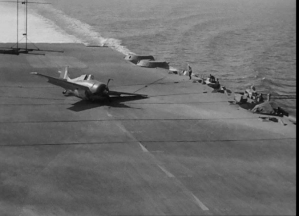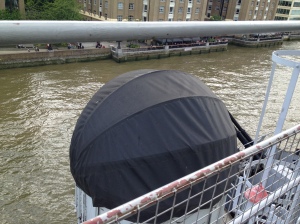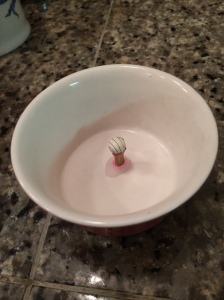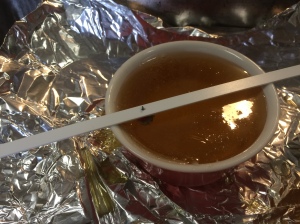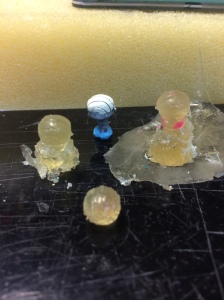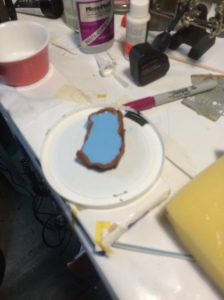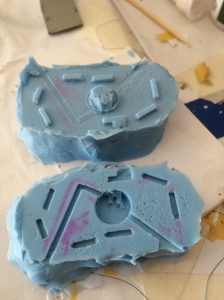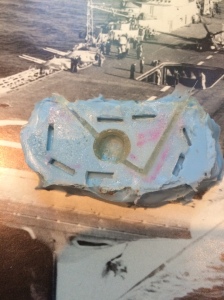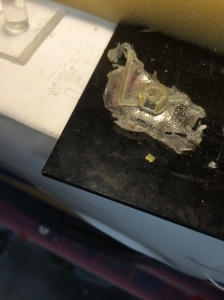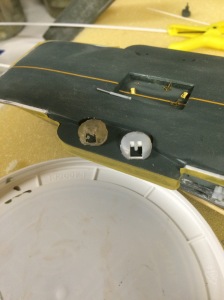With the cold weather, I moved the modeling inside rather than working in the garage so I decided to start work on the Swordfish. I didn’t much care for the detail on the Heller Swordfish included in the box so I purchased three sets of L’Arsenal 1/400 Swordfish. These are pretty good, missing only the TAG’s Lewis (or Vickers) machine gun, bombs, decals, crew and external fuel tanks. You do get torpedoes! You get a nicely detailed resin fuselage. For 1/400 scale, I could hardly complain.
I decided that my diorama would depict my mother-in-law’s wartime boyfriend (Tony Wray) plane as it was taking off (number three in Wave 1) with thirteen planes from Waves 1 and 2 on deck and one plane from Wave 2 with wings folded coming up on the elevator.
A great resource for painting is Airfile Fairey Swordfish which has all the color profiles you will ever need. I was fortunate that a friend stumbled upon this at an airshow at Duxford in late May 2015. Unfortunately for me, one of the four squadrons (Nr. 815) had a different camouflage scheme than the other three squadrons so this meant more variation in masking.
Building a biplane in 1/72 is hard enough but in 1/400, more thought was applied each night when I lay my head down to sleep (Dream Ideas!). I decided that painting each PE component part on its fret and then decaling+sealing would be done before any assembly as masking would be nigh-on impossible once assembled.
Here’s progress to date. First, masking with silly putty, and then with the putty removed. 815 Squadron is on the left of the rightmost photo. Click the p
Now, painting the collector ring. I eventually ended up using miniature rubber washers with a 4mm inside diameter as shown below. Note the cutout made on the inner ring to accommodate the exhaust.

I used Citadel Bronze acyrlic paint and got an OK result across all fifteen aircraft.

As per plan, I wanted to decal before assembly so I started with the tail fins. The Starfighter 1/400 FAA decals for the tail fin stripe were too wide so they had to be carefully sliced along the red and blue bars to make the blue-white-red stripes of equal width. In addition, there is a slight angle at the top to match the rudder polygon. The first tail fin took me 15 minutes but I got faster and could do one every 5 minutes or so. You can see the results here:

The Starfighter 1/400 roundels are too small by about 10-15% for the upper wing so I ordered some 1/350 roundels from Begemot in Ukraine. These just arrived and, unfortunately, they are even smaller than the Starfighter 1/400 roundels and are printed off-register (badly so). Plan B is an order (pending) to Hawk-Graphics for their 1/350 FAA decals but the proprietor said deliveries could take several weeks-to-months (!). Plan C is to try making my own decals.
To get ready for Plan C, I used Inkscape, an open source vector graphics program, to try my hand at roundel making of the proper size. It turned out that for the L’Arsenal Swordfish, it looked like 0.13″ diameter would do the trick.

The color values for the Starfighter roundels don’t look right, color-wise either. They certainly don’t agree with the colors in Airfile Fairey Swordfish or Fleet Air Arm Camouflage and Markings. The red has too much pink or magenta in it. You can see this discrepancy in this photo (port side, Starfighter decal is on the left, proper size and better color is to the right). I’m still working on getting the colors to look right with repeated passes between computer and printer. And of course, on decal paper, more iterations may be required.

The grainy image comes from the light reflecting off the Future and I assume will be gone once I apply matte finish to the wing after assembly
As much as I was trying to avoid Plan C, I realized that the Archer Dry Transfer miniature numerals for the tail numbers were the wrong font (too short, too wide). This means I have two options:
i) Forego the tail numbers altogether (sad)
ii) Print my own tail numbers as decals.
Option ii) is tricky. For the gray tail fins, the tail number was black so printing decals on clear decal paper is plausible. But for the dark slate gray tails, the tail numbers were white and since I don’t have or want an ALPS printer, I’ll need to print on white decal paper by printing the surrounding area to match the paint color already on the 1/400 models. This is going to mean several iterations to get a color match that will fool the eye. I am not looking forward to this.
Forging on white option ii), I did some sample backgrounds at various RGB values with the requisite tail numbers:

As an aside, there are some interesting web sites with RGB values such as the one on Club Hyper. These provide good starting values but ultimately, what I print has to match what I painted. So, after taking my Dad’s Canon Pro 9000 Mk II photo printer, I printed the above on white decal paper.
Anyway, back to Plan C – making my own decals.
- Attempt #1 was a complete failure. Using Micromark clear waterslide paper, I got a good print and following the Micromark instructions, immediately sealed it with 3 passes of Krylon Crystal Clear 1303A (that I also got from Micromark). I put this aside to dry. When I cut out a decal, and placed it in water, the colors immediately ran. Research then ensued. One model RR thread suggested spraying the decals very lightly once, setting aside for an hour, and repeating. A different poster says spraying never works. The same thread has a suggestion for using Evans Designs waterslide paper that needs no sealing coat. I’ll put the latter idea in my back pocket.
- Attempt #2 was inspired by a Canon printer forum thread pointing out that the 9000 Pro uses dye inks that don’t need sealing, just a period of time to dry. I’m going to go for 24 hours. I noted on some test prints on non waterslide glossy paper that the ink was color fast and needed no sealing (I ran tap water over it). Now, what I don’t know is whether the dye inks will sink into the Micromark water slide paper as they do for photo paper. So, 24 hours later, I applied some water to an image and … it dissolved the color immediately. Oops
- Attempt #3 was a repeat of the above except waiting a few hours, then sealing with a light Krylon coat, waiting another hour, another light Krylon coat, and then waiting overnight. This actually worked until I realized that I had mistakenly printed the decals on white decal paper instead of clear. So, another sheet was prepared on clear and the overcoating process completed. I’ll test it tomorrow.
And, ta-da, attempt #3 worked well. Decals were colorfast. The center red roundel has some opacity issues when applied over a dark upper wing but I can live with it. The miniature tail numbers came out well as you can see in the picture below (before dull coating). You can also see the 65 gallon extra fuel tank in the torpedo-carrying planes (e.g. 5A, 4H, 5H)

Swordfish with tail numbers




